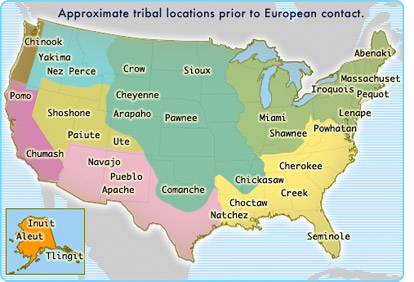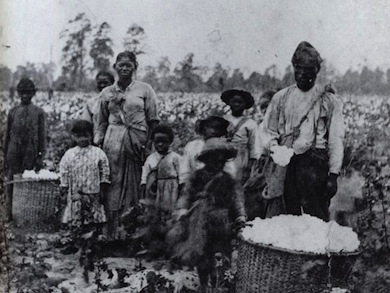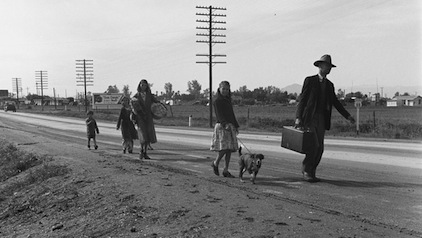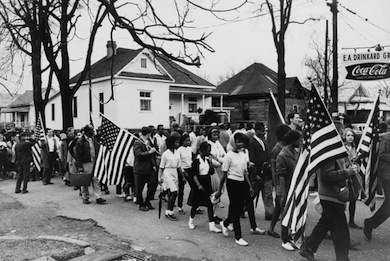The History of the United States, in 10,000 Words
Dan Bryan, December 22 2015
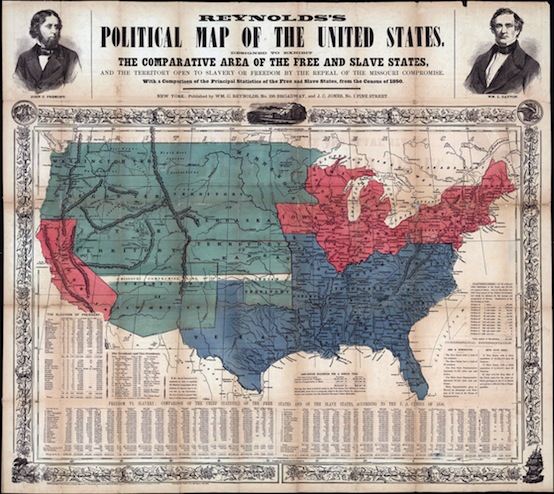 The United States in the 1850s
The United States in the 1850sThe purpose of this article is convey every broad theme of U.S. History in roughly 10,000 words. I'm sticking to the well-beaten path in what I include. For instance, the College Board suggests the following periodizations for their AP U.S. History course/exam. Why do some of them overlap? Why is 1890-1945 grouped into the same "time period"? I don't know, and I don't care. I will follow this outline and present the bare-minimum that any competent student or American adult should know about U.S. History. Or is it American History?
- Before Period 1 <--- (NOT AP, I am including this)
- Period 1: 1491–1607
- Period 2: 1607–1754
- Period 3: 1754–1800
- Period 4: 1800–1848
- Period 5: 1844–1877
- Period 6: 1865–1898
- Period 7: 1890–1945
- Period 8: 1945–1980
- Period 9: 1980–Present
- Conclusion
Knowing everything in this article won't guarantee an A+, or a 5 on the AP exam, or a MacArthur Genius Grant, but it should be a good introduction.
Before Period 1
(back to table of contents)There are a couple of no-brainer things to know about North America before 1491. First of all, the consensus is that people arrived in North America around 12,000 years ago. They migrated from Asia during the Ice Age, walking over what used to be dry land, into Alaska. And about that Ice Age -- until 10,000 years ago, much of the continent was covered in ice. Eventually the glaciers melted and receded. This was called the Quaternary Glaciation. It left behind the Great Lakes and the Chesapeake Bay.
The largest American Indian tribes lived in Central and South America. Think Aztecs, Mayas, Incas, etc. In North America, the population was less dense. Even so, the city of Cahokia was built near the modern location of St. Louis, on the Mississippi River. It had many mounds and perhaps 30,000 people at its peak. In the late 1400s, the Iroquois and Algonquin groups lived in the midwest and northeast, the Cherokee lived in the southeast, the Sioux lived in the midwest, and the cliff dwellings of the southwest were already abandoned. There were numerous other tribes, much decentralization, and fluid cultures and tribal boundaries. Wars were fought, people loved each other, developed religions, and lived the entire human experience.
Period 1: 1491-1607
(back to table of contents)Obviously, Christopher Columbus changed some things. Many Spaniards followed in his wake, such as Hernán Cortés who conquered the Aztec Empire. Several also-rans attempted to follow his example in North America, but they got nowhere. Pánfilo de Narváez led 600 men into Florida, and four got out alive. Narváez was not one of them.
The Columbian Exchange is the name given to the massive transfer of crops and people across the Atlantic Ocean after Columbus. For instance, potatoes and tomatoes were entirely unknown to Europe before 1492. By the mid-1800s, Ireland would be growing potatoes galore, sowing the seeds for disaster.
The Spanish created the first European settlement in what is now the United States, at St. Augustine in what is now Florida. They also founded Santa Fe, New Mexico in 1610. But since they made little effort to populate the new territories, they recede to the background of the mainstream U.S. history text until about 1835-1848, at which point Texas and the Mexican-American War come into play. Since the 1960s, millions of Hispanics have immigrated to the United States. This has not been extensively integrated into a lot of history texts, at this point.
As for the English. They created colonies at Jamestown in 1607, and Plymouth in 1620. Each of these colonies has their Indian myth. Jamestown (in Virginia) has Pocahontas. Plymouth has the Thanksgiving dinner with the Wampanoags. In reality, there was quickly conflict with the Indian tribes in both places. The initial English colonies were in marginal areas, and the Indians became quickly depopulated through disease. Because Europeans had lived in tight quarters for centuries, in close proximity to livestock, and so on, they had immune defenses to a number of diseases that American Indians simply didn't. So the Indians died, and those that were left could not defend against further incursions. There were numerous Indian struggles in the early colonial times, but the most significant one was probably King Philip's War. "King Philip" was a Wampanoag chief who attacked the New England colonies in 1675. By 1678 the Wampanoag were virtually annihilated.
The Dutch deserve a brief mention. They founded New Amsterdam, in 1624, which later became New York when the English took it. The Dutch did not go away, and Martin Van Buren and the Roosevelts all had some New York Dutch in their pedigree. And of course, New York itself was perfectly located to become a trading powerhouse as it grew.
Period 2: 1607–1754
(back to table of contents)Why did people move to the English colonies in the 1600s? The answer depends on the person and the colony.
In Virginia and other places to the South, many came as indentured servants. An indentured servant would have their passage paid for by a wealthier landowner. Upon arrival, they would owe several years of labor to their benefactor. For this period of time, they had few rights. At the end they would be released and would now be free to seek their fortune. Men and women alike came this way. Even a few blacks were indentured servants during the early days of Virginia. Those who brought in these servants were often compensated with headrights.
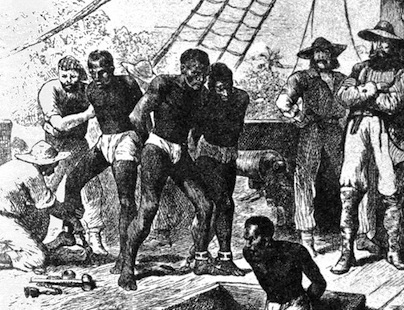 Depiction of the Atlantic slave trade
Depiction of the Atlantic slave tradeThe vast vast majority of blacks arrived as slaves, however. Over the entire period of the Atlantic slave trade, about 450-650,000 slaves were imported into the United States. As they arrived in significant numbers, slavery took on the aspects of a racial caste system. From the perspective of a landowner, slavery was preferable to indentured servitude. And so, in this way, the great evil of the early United States began to take its form. To say the least, the effects of this decision remain with us today.
Slaves did any kind of work there was to do, and some became skilled craftsmen, cooks, or housemaids. But the lifeblood of the Virginia economy was tobacco. The English demand for tobacco was insatiable, and Virginia had the optimal climate and soil to cultivate it. So most slaves became field-workers, and this trend would continue in the future on the rice and cotton plantations.
Former indentured servants who could not afford slaves were often shunted off to the backcountry, in proximity to hostile Indians. For those tribes who had lived directly on the Atlantic Coast, the 1600s were a grim time. For others, however, the situation was different. For over a century, the Appalachian Mountains were a formidable defense barrier, and those who lived behind the range such as the Cherokee, Iroquois (a confederation of tribes), and Algonquin (a language group) appeared for the moment to be safe. In fact, many of these tribes saw newfound prosperity as they profited from the fur trade. Both the English and French sent fur traders into the hinterlands to bargain with Indian tribes, and they would often trade guns, nails, cloth, and alcohol for the immensely valuable beaver pelts.
The French had far fewer settlers, and were much more exclusively focused on the fur trade than the English were. The French had many Indian allies including most of the Algonquin peoples, while the English were closer with the Iroquois. This was the alignment in many Indian wars which culminated in the French and Indian War.
People who moved to New England were more often seeking religious freedom. The official church in England was the Anglican Church, which predominated in Virginia. In New England, Dissenters such as the Puritans and Brownists predominated. They had a harsher set of rules governing beliefs and conduct than other colonies, and banished some who disagreed. Roger Williams founded Rhode Island and Anne Hutchinson was an early resident.
The differences between New England and Virginia were paralleled violently by the English Civil War in the mid-1600s. Oliver Cromwell succeeded in overthrowing the monarchy and ruling England as a "Lord Protector", but that system could not long survive the death of Cromwell himself, in 1658. Some who fought against Cromwell were banished to Virginia, enhancing that colony's "cavalier" credentials. The monarchy was restored in 1660, and the "Glorious Revolution" occurred in 1688. The power of Parliament increased greatly, and oversight over the colonies generally diminished.
The early 1700s get very little coverage in U.S. History books. The colonies were generally agricultural and prosperous. Slavery continued to expand in the southern colonies, though it was present everywhere. England, eventually known as Great Britain or Britain, maintained a de facto hands-off policy towards the colonies. There were a laws in place called Navigation Acts to regulate colonial trade, but they were largely ignored. This (unofficial) policy has been known as "salutary neglect".
The First Great Awakening was a prominent religious movement, lasting many years. Revivalist preachers traveled the countryside and preached a more personal form of religion. "American" sects like the Baptists and Methodists gained converts, and religion as a whole became more emotional and individualistic in the colonies. There have been other Great Awakenings since, and they all anticipated the decentralized, splintered, emotional, charismatic forms of Christianity which thrive in many parts of the United States to this day.
 Benjamin Franklin
Benjamin FranklinOne famous colonial was, obviously, Benjamin Franklin. Franklin was a polymath who published, experimented, invented, and lived to the fullest that the times allowed. He spent most of his life in Philadelphia, which was a large, tolerant town, in a colony founded by Quakers. He had a wide reputation that allowed him to play a large influence later on, during the Revolution and finally during the Constitutional Convention.
Period 3: 1754–1800
(back to table of contents)The French and Indian War was so-named because the French and the American Indians largely fought on the same side, against the British and the colonists. Most Iroquois, however, fought with the British. By this time, many tribes could see that the British colonies were poised to expand westward, and that their own best hope laid with the French. The French had far fewer settlers and were more interested in the fur trade than in large-scale settlement. Unfortunately for their Indian allies, the French lost the war and were largely expelled from the American continent. The English took over what is now Canada, along with the interior of North America. After a rebellion by Pontiac, the English marked a line in the Proclamation of 1763 which forbade colonial settlement west of the Appalachian Mountains. This became the first of many acts which infuriated the colonists and led to the American Revolution.
The British had also spent heavily to fight the war, and they tried to recoup the costs by expanding their taxation of the colonies. The first act they passed was the Stamp Act, which taxed many kinds of paper and official documents, and caused an uproar. Colonial protest was so great that the Act was repealed, but more acts followed in the late 1760s and 1770s. The Townshend Acts, the Tea Act, the Intolerable Acts, and the Quebec Act. Each time, colonial protest became more organized. Groups were formed, such as the Sons of Liberty. Militia units began to drill. The Boston Tea Party protest was executed in 1773. Politicians and intellectuals began to cite their John Locke, their Montesquieu, their "Cato" by Joseph Addison, and so on, and honed their theories of rights, obligations, and relationships in a civil society. Perhaps a change of course by Britain could have led to a very different outcome, but it was not to be.
Shots were first fired at Lexington and Concord, on April 19, 1775. A Continental Army was raised by the Second Continental Congress. The Army was commanded by George Washington, while the Congress functioned as a de facto government and eventually wrote the Articles of Confederation.
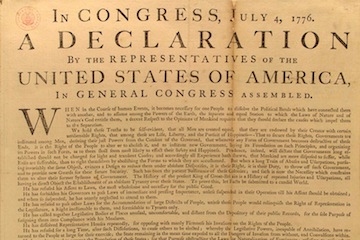 The Declaration of Independence
The Declaration of IndependenceEven after blood had been shed, the colonists made a final attempt to smooth things over with the Olive Branch Petition, but by 1776 the course was set. The Congress decided to draft the Declaration of Independence. Thomas Jefferson wrote it, collaborating with John Adams. This, the most important founding document of the United States, was signed on July 4, 1776, the nation's Independence Day. It listed many specific grievances against the British, and also included its famous opening statement on human rights; "We hold these truths to be self-evident, that all men are created equal, that they are endowed by their Creator with certain unalienable Rights, that among these are Life, Liberty and the pursuit of Happiness."
Needless to say, the United States won the Revolutionary War. George Washington gained a national reputation for his command. The aid of the French was decisive; the surrender at Yorktown monumental. The Treaty of Paris, in 1783, recognized the independence of the United States and ceded the new nation a tract of land which stretched to the Mississippi River. The new country would be governed under the Articles of Confederation. Washington rode off to a glorious retirement, and all was well for a fleeting moment.
The truth is, the United States had numerous problems as a new country. Many states were in debt, the national government could not raise revenue, a single state could veto legislation, and in the background many worried that the new nation would fail and be invaded by Britain or another country, and that the entire experiment in liberty would be for naught. Such sentiment would lead to the Constitutional Convention, the Federalist Papers, and to some extent the Federalist Party.
Of course, on the other side, plenty of individuals did fine in the 1780s, and they feared an increase in power by the national government. They didn't want standing armies, strong revenue collections, and so on. In their mind, they had just fought the Revolution to prevent these types of encroachments. Such sentiment would lead to the Anti-Federalist movement, and to the early mentality of the Democratic-Republican Party.
State governments handled their affairs with varying degrees of ability. Some paid off their debt, while others failed to. Some had violent internal conflicts. In Massachusetts, Shays' Rebellion broke out late in 1786 and terrified many. Armed bands of the working-class roamed the countryside, protesting state taxes and land seizures, and using the rhetoric of the Declaration of Independence. To most of the Founding Fathers, this was a gross misunderstanding of their principles and implied a descent to anarchy.
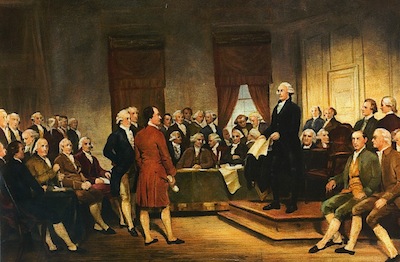 The Constitutional Convention
The Constitutional ConventionShays' Rebellion gave a new impetus to the Constitutional Convention, which met in 1787 in Philadelphia to discuss the Articles of Confederation. In this case, "discuss" meant "throw them out and start from scratch". The entire legal structure of the United States was rewritten, with much participation from James Madison in particular. Three branches of government were established. The House of Representatives and Senate were created. The method for electing a President was detailed. The federal judiciary was outlined. The powers and checks of each branch were agreed on. The powers of the federal government itself were outlined. The Three-Fifths Compromise became a shameful and controversial clause. And the Constitution was sent to the states for ratification.
The Anti-Federalists, described already, opposed the Constitution. Ultimately, the compromise was for the Constitution to be ratified, and for a Bill of Rights to be passed by the first Congress. This contained ten Amendments which protected free speech, the right to a jury trial, the right to be free from unreasonable searches, and so on. The Supreme Court was also established by the Constitution and its decisions on these amendments and many other aspects of the Constitution have further shaped the document.
Many more details of the federal government were worked out during George Washington's Administration. Departments were created, and Washington appointed a Cabinet of Secretaries to head them. Alexander Hamilton became the first Treasury Secretary and worked on fixing the nation's financial situation, and on establishing a national bank. Thomas Jefferson also served in the first Cabinet, while John Adams was the first Vice President. Every President since has had a Cabinet, and has been largely free to appoint and fire its members.
Washington retired after two terms, setting a precedent that would last until 1940. John Adams served a much less popular term from 1797-1801, during which political parties came to the forefront. The Alien and Sedition Acts were a particularly controversial aspect of Adams's term, and were strenuously denounced by Thomas Jefferson. Jefferson defeated Adams in the 1800 election, which he called the "Revolution of 1800".
Period 4: 1800–1848
(back to table of contents)Let's pause and consider what the United States was like in 1800. The population was expanding westward, Kentucky and Tennessee were states, and conflicts with American Indians were resurfacing violently. Northern states were in the process of abolishing slavery, but Eli Whitney's cotton gin was opening an entirely new region to plantation agriculture in the South. The heritage of the nation was overwhelmingly English and Scottish ("Scots-Irish" was also used, describing Scottish immigrants from is now North Ireland). Women had few legal rights. Married women could not own property and were barred from any number of financial transactions. The professions (medicine, law, etc.) were closed to women. Very few people of any gender could vote -- there were usually strict property requirements. The United States was prosperous in comparison to other nations, but life was still brutal and short by modern standards. Diseases could strike a person down in any stage of life. Malaria, hookworm, cholera, typhoid, milk sickness, and infections could easily be fatal. Women gave birth to about seven children, on average, and cheated death every time they did so. The infant mortality rate was well over 200 per 1,000 live births. Such measures of well-being were even worse for slaves. Nearly everyone was a farmer or a farm laborer. Anyone who moved west to obtain land risked massacre by American Indians. Land titles were ill-defined, and litigation could sometimes force a family from a plot which they had worked for years.
The most important event of Jefferson's Presidency was the Louisiana Purchase. For $15 million, the United States purchased 827,000 square miles of land from France, and took its first step towards its ultimate expansion "from sea to shining sea".
A world event which lingered in the background was the Napoleonic Wars. Because of these wars, Britain often raided American shipping and captured American sailors to draft ("impress") into its navy. Britain also occupied some forts in Michigan and elsewhere and continued to ally with certain Indian tribes, and was in general an irritant to the United States during this period. Southern planters were furious because cotton shipments were being intercepted. Westerners were furious because they blamed Britain for the Indian attacks, and for holding back western settlement. Some even dreamed about annexing Canada. All of this led to the War of 1812, declared by the United States.
The war itself was somewhat inconclusive. After a couple years of fighting, Britain agreed to a peace treaty and took the United States more seriously in the future. The Star-Spangled Banner was written. The American Indians were the big losers (Tecumseh's forces were badly defeated, and he was later killed). Andrew Jackson became famous.
After the war, the "Era of Good Feelings" followed. The Federalist Party died, and almost everyone supported James Monroe. Nationalism was ascendant, and many began to dream of national roads, industrialization, and a rising, prosperous United States. There was a new national bank (the Second Bank of the United States). Henry Clay was the spokesman for this group, and pushed for the "American System". Settlement expanded west, land values rose, and then they suddenly crashed. The Panic of 1819 caused land values to sink, broke many banks, and led to unemployment in the cities. Many farmers could not repay their loans and went bankrupt. Thus, the "Era of Good Feelings" came to an end.
The conflict over the admission of Missouri in 1820 foreshadowed the Civil War to eventually come. Missouri sought admission as a slave slate. Many found that idea anathema. An elaborate compromise was worked out, in which Maine was split from Massachusetts and admitted as a state, and it was agreed that no other state as far north as Missouri would be admitted in the future. Everyone celebrated at the time, and the Missouri Compromise enjoyed a sacred place in American law and history until the 1850s.
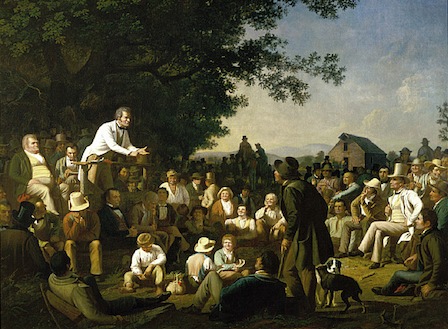 Jacksonian Democracy in action
Jacksonian Democracy in actionThe lower classes in the various states began to participate heavily in politics. Many states removed property restrictions from the vote, leading to what was called "universal suffrage" at the time. This, of course, meant universal suffrage for white males. They soon had a political hero in Andrew Jackson, who ran for President in 1824. Although Jackson received a plurality of the vote, the election was thrown to the House of Representatives and John Quincy Adams was selected. Jackson denounced the "Corrupt Bargain" which had occurred, and came back four years later to take his revenge. Jackson was also a founder of the Democratic Party, which survives to this day. On the state level, his followers rewrote many constitutions. Overall, they advocated for aggressive westward expansion (more land for people of modest means), the "spoils system" (more jobs), and against national infrastructure spending and the Second Bank of the United States (they saw national institutions as tools of the eastern elite). Jackson was elected in 1828, and many people of means wondered if the country would survive.
The "spoils system" was associated with the phrase, "to the victors go the spoils". The Democrats believed in patronage politics, with Jackson as the leader. Besides personal benefit, they argued that office-holders would be accountable for the poor performance of appointed officials, and that more people would have a stake in the government. Of course, this also opened the door to corruption and machine politics, which would proliferate in many areas into the 20th century.
In the southeast, many American Indians took up farming, formed governments based on the Constitution, owned slaves, and dressed similar to the white people of the time. Collectively they were known as the "Five Civilized Tribes" -- the Cherokee, the Creek, the Choctaw, the Chickasaw, and the Seminole. They had sympathizers, but in 1830, Congress narrowly passed the Indian Removal Act to resettle these tribes to Oklahoma. Jackson supported this. Over the next decade, thousands of Indians died on the Trail of Tears, and whites moved into the vacated land. This was one of many similar instances which occurred over the centuries, and which is inextricably tied to the growth of the United States. For without the resettlement or death (even if by disease alone) of many thousand Indians, there would hardly be a United States, and there wouldn't be this article.
Jackson also turned his sights on the Second Bank of the United States, and succeeded in getting Congress to vote down renewal of its charter. This was the central political issue of the 1830s that divided Democrats and Whigs, another new party. The Democrats largely won on this issue, and the United States functioned for many years without a national bank.
Railroads began to be built by the 1840s, and the United States began to industrialize in other ways. The Erie Canal was finished in 1825, and led to the explosive growth of New York. Textile mills were built in New England, near that region's fast-flowing rivers. "Mill girls" worked in these until cheaper immigrant labor could be substituted. In fact, the 1840s saw a large influx of non-Anglo immigrants from Germany, and especially from Ireland. Many of them were Catholic, and aroused much excitement and backlash, which culminated in the formation of the anti-immigrant Know Nothing Party.
There was a movement during this period to expand women's access to education. Forward-thinking women saw this as a way to eventually win other rights and concessions. Traditionalists believed that women had a responsibility to educate their children in the ideals of the republic. In 1848, the first women's rights convention was held in Seneca Falls, New York. The Declaration of Sentiments was written by Elizabeth Cady Stanton and widely disseminated in newspapers. It attacked women's legal and professional position and called for increased voting rights. It was a shocking document for its time.
Period 5: 1844–1877
(back to table of contents)Manifest Destiny was the idea that the United States would someday expand to the Pacific Ocean. The big obstacle to this, in 1844, was Mexico, which controlled much more land than it does today. Texas was an independent republic, carved out of Mexico, which allowed slavery and was a prize target for Southerners. In 1844, James K. Polk, a Southerner, became President and Texas was annexed into the United States in 1845. War with Mexico soon followed. Democrats supported the war, while Whigs hedged their bets and warned about the expansion of slavery. The U.S. easily won the war and annexed most of Mexico, making Manifest Destiny a reality.
Politics became vicious from this point forward, leading ultimately to the Civil War. Anti-slavery politicians were beginning to appear in the North, and they wanted to prevent the expansion of slavery into the territories acquired from Mexico (see the Wilmot Proviso). Southerners wanted expansion of slavery into these territories and saw anything less as a threat to their position within the United States. The difference was probably irreconcilable, and a couple of attempted compromises in the 1850s had no staying power.
The first of these compromises was the Compromise of 1850. It admitted California as a free state, ignored the Wilmot Proviso, and toughened the enforcement of the fugitive slave laws. This outraged many people and resolved nothing with the rest of the territories.
The second compromise was the Kansas-Nebraska Act in 1854. This allowed Kansas and Nebraska to vote on whether to allow slavery when they became states, which directly overturned the Missouri Compromise. Northerners saw this as more of a capitulation than a compromise, while Southerners still wanted more guarantees. The act completely backfired, as armed bands poured into Kansas on either side and began waging low-scale war against each other, all the while passing competing Constitutions and leaving the issue at an impasse.
Numerous other events worsened relations in the 1850s and drove them towards a crisis point. The Whig Party died because of dissension on the slavery issue. The Republican Party was created, and explicitly opposed the further expansion of slavery. Harriet Beecher Stowe wrote an abolitionist novel, Uncle Tom's Cabin. A pro-slavery Representative caned an anti-slavery Senator on the Senate floor. The Supreme Court ruled that slavery could not be prohibited in the territories, and that blacks weren't citizens, in Dred Scott v. Sandford, and finally, in 1859, events reached a logical conclusion with the attempted uprising of John Brown.
John Brown was a fierce abolitionist who led a band of followers into Virginia and captured a federal arsenal. His plan was to distribute guns to the slaves and foment a general uprising which would bring the system down. He was quickly captured and executed, but not before predicting, ""I, John Brown, am now quite certain that the crimes of this guilty land will never be purged away but with blood."
The next year, Abraham Lincoln was elected President and the southern states began to secede, forming the self-styled Confederate States of America.
Most people in the North believed the Southern states had no legal right to secede, and for a few months there was an impasse, until the federally-held Fort Sumter was bombarded into submission in South Carolina. From that point on, both sides raised armies and the Civil War began. The goal of the Union was to force the Confederacy back into the United States. The goal of of the Confederacy was to preserve its independence. Just about everyone in the Confederacy wanted to preserve slavery. Those in the Union were divided on the issue -- a majority did come to favor this measure, but there was always opposition to it.
Lincoln skillfully led the United States during the Civil War, balancing numerous egos and political factions through what became a gruesome struggle. Over 600,000 people died. A draft was implemented. The reputation of generals Ulysses S. Grant (for the Union) and Robert E. Lee (for the Confederates) was immortalized. And some military tactics like trench warfare and total warfare would foreshadow the brutal world wars of the 20th century.
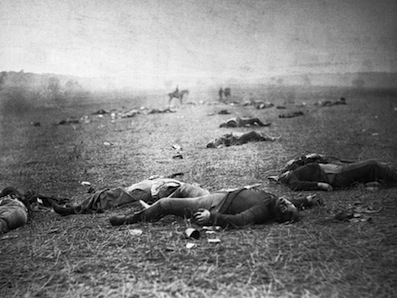 Dead soldiers after the Battle of Gettysburg
Dead soldiers after the Battle of GettysburgThe Union won the war. Lincoln put the writing on the wall for slavery with the Emancipation Proclamation and the Gettysburg Address. He spoke of a "new birth of freedom" and pushed for passage of the 13th Amendment, abolishing slavery in the United States. Many thousands of escaped slaves fought for the Union Army, particularly in the 1864-65 period. Less than a week after General Lee's surrender, on April 14, 1865, Lincoln was shot. A southern sympathizer did the deed, and Lincoln died early the next morning. He is usually remembered as a great President, comparable in stature only to Washington himself.
The period between 1865-77, particularly in the South, became known as Reconstruction. Some process was needed to readmit the states into the Union, ensure they respected basic human rights, and so on. Many Southern states attempted to reestablish slavery in all but name, passing strict laws against the movement and bargaining rights of free blacks in 1865. Congress intervened and passed its own set of Civil Rights and Reconstruction Acts, all the while fighting with President Andrew Johnson (the acrimony led to Johnson's impeachment in 1868).
Congress, controlled by Republicans, sought to ensure that blacks would have full voting rights in the South and would be protected from violence. There were two great motivations for this; one was a humanitarian concern for the freed slaves, and the other was a chance for Republicans to utterly dominate state and national elections for years to come. Southern whites invariably focused on the selfish motive, accused Republicans of exploiting freed slaves for their votes, and largely supported the Democratic Party. If they couldn't win at the ballot box, they won by other means. Violence, vote fraud, murder, intimidation, and secret societies were commonplace. The most notorious of the secret societies was the Ku Klux Klan. Though the Klan itself was suppressed by federal troops, its legacy lived on. Almost as soon as Reconstruction ended, blacks became disenfranchised and were consigned to the bottom rung of the Southern social hierarchy. The eventual result was debt peonage, Jim Crow laws, and total segregation of society.
Period 6: 1865–1898
(back to table of contents)While the disgraceful story of Reconstruction was being written, other things were happening in the United States. In fact, most of the groundwork for the ascendance of the United States as a dominant economic power was laid in the late 19th century. By almost any measure, industrial production exploded in this era. Steel, oil, railroads, communications, clothes, food, farming, utilities, and other areas were revolutionized. Prosperity expanded in general, but the advances created an underclass of dispossessed rural farmers and newly arrived urban immigrants. Many later political movements would arise from the plight of these people.
First of all, however, let us consider the United States in 1865. Few people traveled much, though railroads were coming into widespread use. Oil was just starting to be refined. The coal and steel industries would expand dramatically. Communications were driven by the telegraph, itself a huge improvement on ancient means. There were very few Italians, Poles, Jewish people, or Eastern Europeans in the country. And, still, most people worked on farms.
The industrial tycoons made their names synonymous with the age, which came to be known as the Gilded Age. John D. Rockefeller developed oil fields with Standard Oil. Andrew Carnegie built steel with U.S. steel. Vanderbilt, Stanford, Hill, Morgan, and others were involved in railroads. Thomas Edison did far more than invent the lightbulb; he founded General Electric. George Westinghouse and others developed large-scale electric power companies. Richard Warren Sears and Aaron Montgomery Ward were pioneers in the mail-order business. Richard Macy, John Wanamaker, and Marshall Field brought consumerism to the masses with their department stores. All of these men became enormously wealthy. It would be Mark Twain who invented the term "Gilded Age", but it was these types of men who he was thinking about when he did so.
Beginning around 1880, massive waves of immigrants began arriving in the United States. Many came from places like Italy, Poland, Austria-Hungary, Serbia, and Russia (if from Russia, they were often Jewish). They arrived in northern cities and worked for stockyards, coal mines, steel mills, railroads, and numerous other factories. They worked for lower wages than other Americans would. Many worked in unskilled jobs. Industrialists supported this open immigration policy because of the cheap labor it ensured. Industrialists also supported high tariffs to protect American industry. These became policies of the Republican Party, along with other business-friendly measures.
Women of means did not work outside the home, but many immigrant and working-class Southern women worked in textile factories as the century progressed. Blacks and working-class women of all national origins were frequently employed as domestic maids as well. Teaching was also an acceptable profession for an unmarried woman. Women immigrated to the United States in huge waves, just as men did.
The cities and railroads put economic pressure on the farmer. To put it broadly, over time, farming simply became more efficient, and there was less of a need to have 70% of the labor force engaged in agriculture. On a human level, this displaced millions of families and led to much resentment of the railroads, the eastern business class, the big banks, the political parties, and so on. In its less radical form, this led to the Grange movement, which advocated for new farm laws.
Many farmers eventually supported the Populist Party, which won several farm states in the 1892 election. This party called for regulation of the railroads (which discriminated against small farmers), and for inflation. The means of inflation was a silver standard, or "free silver". Farmers hoped that more dollars in the economy would mean an easier time paying mortgages and loans. Ultimately this would allow more farmers to keep their farms and their land. This idea was not implemented, and many farmers had to move to the towns and cities in straitened circumstances. Others became agricultural wage laborers, moving from place to place and picking up work. This was a slow process that stretched over decades. As late as the Great Depression, those farmers who survived would still be advocating for government help and regulation. Now, however, only 2% of Americans make their living in agriculture.
Young people fled from the farms to the cities. People fled other countries for the cities. From all sources, the cities grew enormously, until the United States ceased to become a rural country. Thus, one of the great dreams of Jeffersonian Democracy, the dream of a nation filled with small, independent farmers, faded into memory.
Within the cities, political machines ruled the roost. The most famous machine was Tammany Hall in New York. These organizations took the spoils system to its logical conclusion. Numerous operatives drove the party's vote to the polls on election day, dealt with constituents' concerns, and suppressed the opposition vote. Those who were successful were put on the city payroll, often with jobs that were minor and undemanding. Those areas that supported the machines received more funding for projects. Most political machines were Democratic, but the Republicans had theirs as well. Almost every large city was controlled by such a machine to at least some extent. Tammany Hall in New York was particularly associated with the Irish community in the late 1800s, and there was always some anger from the WASP crowd at how they "corrupted" the game of politics (of course, in reality, there were plenty of scandals to go around in this era).
The first transcontinental railroad was completed in 1869. Others soon followed. Railroads operated in an environment that was made for corruption. Many received land grants from the federal government, or from state governments, which they obtained for free or for cut-rate prices. They could use the excess land to make huge profits -- or to provide kickbacks to friendly legislators. At the national level, the Crédit Mobilier scandal tarred the Grant Administration, but was only one example of a larger problem. Many state governments suffered huge financial losses on deals which had been "railroaded" through the legislature.
The nation still did not have a national bank, and it operated largely on the gold standard. This left banks with little recourse when their investments failed, and it was easy for a small problem to cascade into a national financial panic. The Panic of 1873 caused the Long Depression, while the Panic of 1893 and the Panic of 1907 also did real damage to the economy. During the Long Depression, unemployment jumped up for several years, and working conditions deteriorated. Fed up railroad workers went on strike in 1877, first in West Virginia, and quickly throughout the country. Rail traffic was closed in many cities, rioters burned buildings to the ground, and President Hayes eventually sent federal troops to many cities to suppress the strike and restore order. Workers began to form labor unions in greater numbers after this strike, while the business class took steps to ensure that such disorder could not reoccur.
The first great labor union in the United States was the Knights of Labor, which led a nationwide strike in 1886. The Knights of Labor soon gave way to the American Federation of Labor, which had more staying power. The AFL was fairly moderate in its aims, and tended to represent skilled and semi-skilled labor. Other unions took a more radical stance, or limited their representation to a specific trade or occupation. Other notable unions include the United Mine Workers, the International Brotherhood of Teamsters, the Industrial Workers of the World, and the International Ladies Garment Workers Union.
The United States continued to expand westward during this entire time, displacing the last of the Indian tribes to western reservations. One brief success was achieved by the Sioux, at Little Bighorn in 1876, but the cause was hopeless in the long-term. By 1898, there were 45 states admitted, and American expansion was set to turn its sights abroad.
Period 7: 1890–1945
(back to table of contents)The combination of new immigrants, disaffected farmers, reform-minded women, and other persons of a particular conscience led to the many new reform movements. The Progressive Era is often used to describe the time from the 1890s to the 1920s. Women played a visible role in the progressive movement, in contrast to earlier eras. As the nation became more prosperous, many married women had leisure time to dedicate to societal problems. Many worked on projects of Christian charity, such as the salvation of "fallen women" or the feeding of orphans and so on, but a significant number took up more political causes. The meta-political cause for women was, of course, women's suffrage. Other causes were wage and hour restrictions for women and child laborers, and the greater regulation of business to prevent the abuse and death of workers.
One legacy of the period was Jacob Riis's photography, revealed to the world in his book How the Other Half Lives, which focused on the immigrant tenements of New York. On the national level, progressivism was visible in the Presidencies of Theodore Roosevelt, William Howard Taft, and Woodrow Wilson. Many new laws and agencies were created during this time, such as the Federal Trade Commission, the Interstate Commerce Commission, and the department which would become the Food and Drug Administration. Some states tried to pass labor regulations, but most of these laws were struck down by the Supreme Court until the late 1930s.
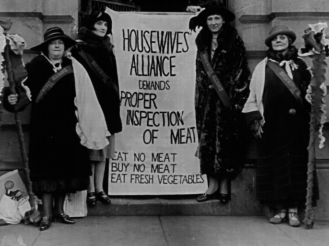 Women campaign for better inspection of meat during the Progressive era
Women campaign for better inspection of meat during the Progressive eraReformers focused on the evils of alcohol as well, gradually building support for what became Prohibition. This was in large-part a rural issue, but progressive supporters believed that immigrant communities would be more productive, and have lower rates of violence, if alcohol was not prevalent. The 13 year era known as Prohibition (1920-1933) had many unanticipated problems, however, not least of which was the rise of violent gangs like that of Al Capone. The issue has since receded from political debate.
Susan B. Anthony was an early advocate of women's suffrage, but she did not live to see her dreams come to fruition. A new wave of activists, such as Carrie Chapman Catt and Alice Paul, arose to drive the issue forward in the 1910s. Eventually this resulted in the passage of the 19th Amendment, in 1920, giving women the right to vote cross the country.
In 1898, the United States went to war with Spain and acquired Puerto Rico, Cuba (briefly), and the Philippines. Imperialists and anti-imperialists debated the legitimacy of this development, but voters sided with the imperialists. The United States also modernized its navy into the Great White Fleet, and began to frequently intervene in Latin American affairs. Once such intervention led to the creation of Panama. The United States then worked towards the completion of the Panama Canal, which opened in 1914.
When World War I began, the United States was initially neutral. Politics, finance, and provocation from Germany eventually pushed the nation to enter the war in 1917. The United States had never fought in a major European war until this time, but its forces were crucial in pushing Germany back in 1918, and in winning the war for the Allies. President Wilson had grand plans for the postwar world, but he was thwarted by domestic politics. The United States retreated to a more independent stance which would leave the country as a bystander in the run-up to World War II. The war was also noteworthy for the radical anti-German sentiment which swept the country, and for the violent summer of 1919 which followed it.
The 1920s saw continued urbanization, this time driven by the automobile. Henry Ford added his name to the list of industrial tycoons, but he also paid his workers higher wages and limited the working day in his factories. His Model T dominated the car industry for 20 years, and reinforced Detroit's position as an industrial powerhouse.
Politically, the 1920s were a conservative time. Culturally, they were forward-looking. Writers and sophisticates of the time took a more cynical tone towards social progress and politics, and focused more on hedonism and the loss of innocence after World War I. Disaffection with Woodrow Wilson, the passage of the 19th Amendment, and Prohibition all drained prestige (or at least removed the impetus) from the Progressive movement. In culture, dresses got shorter, women became more assertive, employment opportunities expanded, and people continued to leave the farms. The 1920s were a terrible time to be a farmer, as prices for food continued to fall. The 1930s would be even worse for this group.
Until the 1910s, over 90% of blacks continued to live in the South. Jim Crow laws were passed and strengthened in the 1890s, and even upheld by the Supreme Court. Lynchings reached their high point in the early 1900s. Successful blacks, and the neighborhoods they lived in, were often targeted for attacks. One of the worst incidents was the Tulsa Riot of 1921. A debate raged between people such as Booker T. Washington and W.E.B. Dubois on how the community should handle these problems. Dubois advocated a more assertive approach, and helped found the National Association for the Advancement of Colored People in 1909.
Starting in the 1910s, many blacks began to leave the South. This process was known as the Great Migration and led millions to move to the industrial cities of the North. Contributors were falling cotton prices, declining immigration, and a continued need for factory labor. Blacks lived better than they did in the South, but they were not entirely welcome in the North. One example of the welcome they received was the Chicago Riots of 1919. Overall, the Great Migration is one of the largest internal migrations in the history of the world. At the same time, foreign immigration came to a near halt with the Immigration Act of 1924 and the Great Depression.
The Great Depression began in 1929, with a large fall in stock prices. It led to a complete realignment of politics, and the creation of many federal programs after the 1932 election of Franklin Roosevelt. Roosevelt implemented the New Deal, which most notably included the Social Security Act. Many other programs were phased out during World War II, but Social Security remains a central part of American politics, providing an income to tens of millions of Americans.
One aspect of the Great Depression was an enormous banking crisis. The Federal Reserve System had been created in 1913, but it could not address the problem of widespread bank runs on consumer banks. After a near collapse in 1933, Roosevelt and Congress created the Federal Deposit Insurance Corporation, which insures most bank accounts in the United States.
Farm subsidies were also introduced in the Depression, to help farmers by reversing the decline in food prices. Since this time, a system to pay farmers to limit production has been in place, managed by the Department of Agriculture. There are also insurance programs to reimburse farmers for crop failures. Even so, millions of farmers were dislocated, particularly in the Dust Bowl.
Roosevelt's programs, which are only briefly covered above, were highly popular and he easily won reelection in 1936, and two more times thereafter. The "New Deal Coalition" be built lasted for decades and gave the Democrats a fairly consistent Congressional majority until the 1990s.
Roosevelt was repeatedly thwarted when it came to foreign policy, however. He wanted to build up the military and provide aid to Britain and other countries opposed to Germany. Most people, however, supported isolationist politicians who demanded strict neutrality and opposed military aid. After World War II, many people would blame this policy for the rise of Nazi Germany, and would push for a much more active role in world affairs for the United States. The internationalists largely won this debate, helped by fear of the Soviet Union, and the United States has undertaken a more aggressive foreign policy ever since.
While World War II began in 1939, or 1937 if the Japanese invasion of China is included, the United States stayed out for the first two years. It was only after the Japanese bombing of Pearl Harbor on December 7, 1941 that the United States declared war. For whatever reason, Germany honored its alliance and joined Japan by declaring war, even though it could ill-afford an enemy the size of the United States. It is possible that, without this gesture, the United States might not have fought against Nazi Germany.
The war overturned every aspect of American life. Goods were strictly rationed, millions of men were mobilized in the military, women and minorities obtained many prime industrial jobs, and the economy finally left the Great Depression behind. Unemployment became virtually non-existent. Factories were re-tooled for military use, producing tanks, guns, bullets, shells, and supply ships. The liberty ship had a simple design and almost 3,000 were built.
Militarily, the United States was overwhelmingly successful, albeit at high cost to human life. Germany and Japan were both defeated in 1945 -- Germany with the help of the Soviet Union, and Japan with the help of the atomic bomb. Dwight Eisenhower, Chester Nimitz, Douglas MacArthur, and Omar Bradley were prominent commanders. Eisenhower would later serve as President of the United States on the strength of his war exploits.
Period 8: 1945–1980
(back to table of contents)The United States had not even recognized the Soviet Union as a country until 1933, but during World War II the nations became allies in what, for the Soviet Union at least, was a life-or-death struggle. Many hoped the two sides could collaborate after the world to build the United Nations into a true arbiter of world peace, but alas, events turned out differently.
During World War II, there were three conferences where the leaders of the United States (Roosevelt and Truman), Great Britain (Churchill and Attlee), and the Soviet Union (Stalin). They were at Tehran, Yalta, and Potsdam. At these locations, the leaders divided postwar Europe into spheres of influence and laid the framework for the United Nations. In theory, every country in Europe would hold free elections to decide its form of government. In practice, countries under Soviet occupation became communist, and countries under U.S./U.K. occupation did not. Before long, the Cold War had begun.
Many world events during the later 20th century were tied to the Cold War: the Berlin Airlift, the Marshall Plan, the Truman Doctrine, the Korean War, the 1953 Iranian Coup, the U-2 Spy Plane Incident, the Kitchen Debate, the Berlin Wall, the Cuban Missile Crisis, the Vietnam War, and the Soviets' Afghanistan Invasion. This is only the beginning of any complete account.
Economic growth after World War II was rapid. Many veterans bought homes, went to college, or started businesses under the G.I. Bill. The suburbs expanded to meet a housing shortage. After dislocations and strikes in the 1940s, prices and growth remained fairly consistent into the late 1960s. This environment led to a mentality that only a few remaining problems needed to be solved before society could reach permanent prosperity. Politicians on both the left and the center-right increased funding for housing programs, education, infrastructure, health and welfare spending, and scientific research. The culmination of this trend was the Presidency of Lyndon Johnson. Johnson implemented many new regulations, anti-poverty programs, and Medicare, as part of his Great Society initiatives. After he crushed Barry Goldwater in the 1964 elections, some commentators believed that the country was entering a new, permanent era of liberalism. The disillusionment with this premise, and the programs and economy it led to, would eventually feed the rise of a more conservative Republican Party.
Demographically, a huge long-term consequence of World War II was the wave of babies born after it concluded. This was true in the United States and around the world. The generation born from 1946-1964 became known as Baby Boomers, and they came to dominate politics and culture during their prime years.
Culturally, television became widespread in the 1950s and soon dominated the entertainment and news industries. Cinema viewership declined. News anchors themselves became a part of the American experience. Walter Cronkite's announcement of Kennedy's death, or his criticism of the Vietnam War, for example, are commonly cited.
A new era of Civil Rights was foreshadowed when Harry Truman desegregated the Armed Forces by Executive Order, in 1948. The Supreme Court, however, issued a thunderbolt with its 1954 Brown v. Board of Education decision, which ruled that segregated schools were unconstitutional. The next year, Rosa Parks was famously arrested and Martin Luther King Jr. led a bus boycott in Montgomery, Alabama. By the 1960 election, civil rights was a national political issue. Activists demanded integrated schools, voting rights, desegregated lunch counters, fair housing and employment practices, and federal protections. Their Southern opponents blundered in a new era of television, turning on fire hoses to clear the streets of protestors, blocking schoolhouse doors from the admission of black students, and bombing houses and churches. King had much support outside of the South through the mid 1960s. He became much more controversial when he advocated against housing segregation in northern cities, or spoke out against the Vietnam War. Even so, other black activists took much more radical positions. Malcolm X, Huey Newton, Bobby Seale, and Stokely Carmichael are prominent examples.
Congress passed the Civil Rights Act of 1964, the Voting Rights Act of 1965, and the 24th Amendment in response to the Civil Rights movement. It legislated an end to housing segregation and established the Equal Employment Opportunity Commission. Federal jobs and appointments became much more balanced among different races and genders. However, public support was severely tested by a series of over 100 race riots from 1965-68, in which hundreds were killed and many thousands of buildings destroyed. After King's assassination in 1968, in particular, the impact of the civil rights movement became much more ambiguous.
Feminism became a huge social and political movement of the 1960s. Betty Friedan, Gloria Steinem, and many others were prominent. Feminists advocated for fair employment practices, increased respect for working women, access to birth control and abortion, a change to social norms, and for the passage of laws protecting women's equality. The feminists were broadly successful in changing societal expectations, as women's employment did skyrocket in the 1960s and afterwards. They also ensured the passage of much legislation protecting women's rights, such as the establishment of the EEOC (referred to above), and other anti-discrimination statutes. One glaring failure was the defeat of the Equal Rights Amendment in the 1970s, along with continued pay inequality for working women.
Aggressive Cold War foreign policy reached its culmination in the Vietnam War. Almost 60,000 American troops were killed, and discontent with the war became widespread by the late 1960s. A huge counterculture emerged, which coalesced in large part around antiwar activities and sentiment. However, people of all ages opposed the war, and older people were even more likely to oppose it than younger people. The withdrawal of troops came in 1973, and for a decade the U.S. scaled its foreign policy back substantially.
Distrust with government was exacerbated by the Watergate scandal, which resulted in the resignation of Richard Nixon. It was made worse by the economic problems of the 1970s. Inflation and unemployment were both high throughout the decade, with two separate oil shocks causing long lines and some rationing. The capture of the U.S. Embassy in Iran made the country look somewhat powerless in foreign affairs, in pitiable contrast to the swagger with which it had held itself in the 1950s and previously. All of this provided an opening for a new direction in politics and the economy.
Period 9: 1980–Present
(back to table of contents)The United States since 1980 has changed enormously, but often in ways that are not evident to the naked eye, such as communications. The Information Age has come into full swing, with consequences that are only beginning to be experienced. In 1980, there was no world wide web, and there was barely an internet. There were no mobile phones. The average consumer had no computer, and those which existed were of limited power. Fast-forward to 2015, and there is credible talk of self-driving electric cars, autonomous home care robots, and human-level artificial intelligence. Nearly every American has access to the internet and uses it regularly. Commentators fear the ability of Americans to silo themselves into socio-political echo chambers, in much the same way they once feared the homogenizing influence of broadcast television.
The demographics of the country have undergone another great transition. The Immigration and Nationality Act of 1965 greatly increased the level of immigration from Asia, which as of 2015 provided the largest number of foreign immigrants to the United States. Many millions of immigrants also arrived from Mexico and Latin America, until the flow tapered off in the early 2010s. Many came illegally, and the Immigration Reform and Control Act of 1986 was designed to deal with the problem. However, illegal migration continued at a large-scale after that law was passed. Overall, this has led to a country where Asians and Hispanics collectively make up a large percentage of Americans, and have made the country much more multicultural. This history has barely begun to be written, as of 2015, and the effects over the next 50 or 100 years are impossible to predict.
Health and longevity continued to improve as the 20th century progressed. In 1900, the average American could expect to live around 47 years. In 1950, that number was about 68 years. By 2000 it was around 76 years, and still increasing. This is an indicator of much better medical technology, less dangerous jobs, low maternal mortality, and better nutrition (albeit with an increasing obesity problem). As more people lived into old-age, particularly from the already-large Baby Boom generation, the potential for a huge strain on Social Security and Medicare increased. It also remains to be seen if this will be an American crisis, or much ado about nothing.
As for a timeline of events, 1980 saw the election of Ronald Reagan as President, which is loosely tied in with a conservative resurgence which was still gaining momentum, as of 2014. Reagan rode a wave of dissatisfaction with Jimmy Carter, inflation, and liberalism in general to win two huge election victories. He pushed for tax cuts, defense spending increases, and a new push to win the Cold War. Reagan's strategy was to place a fiscal burden on the Soviet Union that it could not hope to support, by re-escalating the arms race. It was a controversial idea, but the collapse of the Berlin Wall, the Warsaw Pact, and the Soviet Union itself must serve to vindicate it at least somewhat.
Consumer credit, derivatives, mortgage debt, and corporate acquisitions all increased greatly beginning in the 1980s. Some argue that this eventually caused the 2007-08 mortgage crisis, and resulting systemic financial crisis. Others see that episode as primarily a regulatory failure.
Reagan's election indicated the rise of the religious right as a player in American politics. Galvanized by the Supreme Court's Roe v. Wade decision, which legalized abortion in 1973, many fundamentalist Christians left the sidelines and became quite active in politics. The abortion issue remained controversial into the 2010s, but in another area of the culture wars, the gay rights movement made incredible progress in the early 21st century. As late as 2003, it was still legal for states to pass laws against sodomy. In that year, the Supreme Court issued its Lawrence v. Kansas decision, declaring those laws unconstitutional. In 2004, Massachusetts became the first state to legalize gay marriage. In 2015, only 11 years later, the Supreme Court ruled in Obergefell v. Hodges that gay marriage is a right protected by the 14th Amendment.
After the Soviet collapse in 1991, many speculated that a new era of peace and democratization was at hand. These illusions were blown apart on September 11, 2001. Al-Qaeda terrorists hijacked four airplanes, severely damaged the Pentagon, and destroyed the World Trade Center in New York. Almost 3,000 people died.
How to deal with these attacks soon became a controversial political issue. The U.S. quickly sent troops to Afghanistan, to overthrow the Taliban government there. In 2003, more controversially, it invaded Iraq with the goal of destroying that nation's stores of weapons of mass destruction (WMD) and overthrowing Saddam Hussein. When the alleged WMD were nowhere to be found, public opinion turned against the war. American efforts to instill democracy in Iraq had mixed results, at best, and are still inconclusive as of 2015. In the 2010s, Al-Qaeda became overshadowed by a splinter group known as the Islamic State (IS, ISIS, or ISIL). Policy towards this group, and towards a number of civil wars and conflicts in the Middle East, promises to remain a political issue for years to come.
Conclusion
(back to table of contents)This article obviously takes a shotgun approach to American history, and there are many incidents that it glosses over entirely, or gives only token coverage to. Just because an issue is not covered in this 10,000 word summary, does not mean it is not important to the history of the United States. It also does not cover the myriad number of perspectives that exist on any one of these issues, again for lack of space. As always, further reading is encouraged and required. Good luck in your history adventures!
